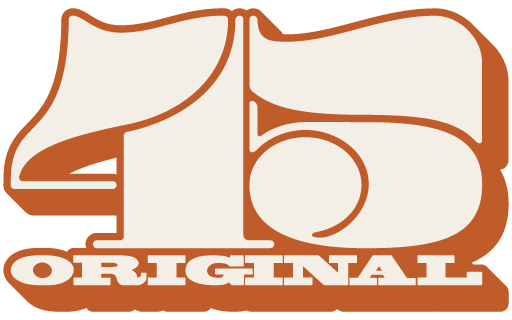MY GENERATION
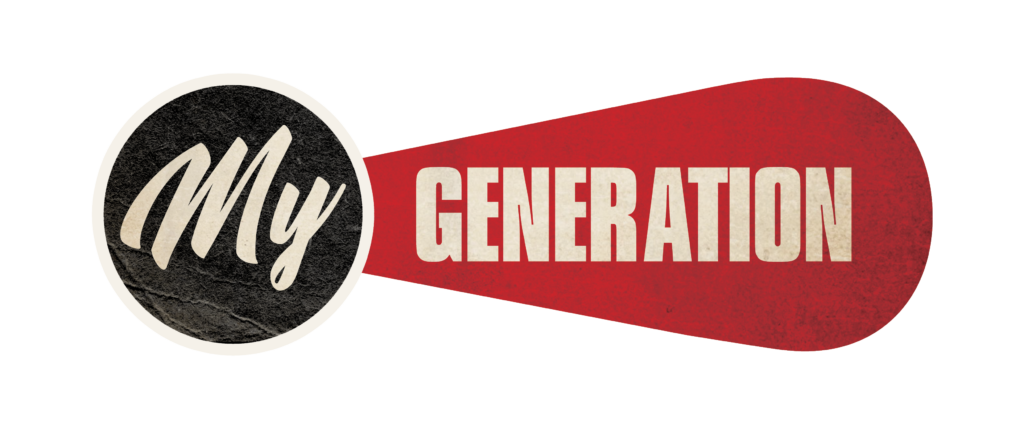
Introducing MY GENERATION a new collection of prints from 45 Original, celebrating the most influential years in music history. From ‘1959 – THE YEAR THAT CHANGED JAZZ’ to ‘1985 – ONE OF THE DEFINITIVE YEARS OF INDIE MUSIC’. Featuring incredible artwork from a number of in house and guest artists, paying homage to the most prolific, iconic and impactful artists of their genre. My Generation is a limited-edition series of prints, featuring four individual runs of 100 500x500mm signed and numbered prints.
1959 – THE YEAR THAT CHANGED JAZZ
Designer: Bruce Fisher (Tour Design / 45 Original)
The year 1959 holds significant importance in the history of jazz, marking a pivotal moment in the genre’s evolution. Renowned jazz historian Nat Hentoff famously referred to 1959 as “the year that changed jazz,” highlighting the release of several seminal albums that pushed the boundaries of the genre and reshaped it forever. From Miles Davis’ “Kind of Blue” and Ornette Coleman’s “The Shape of Jazz to Come,” to Charle Mingus’ “Mingus Ah Um” and Dave Brubeck’s “Time Out.” Scroll down for more information!
1967 – THE SUMMER OF LOVE
Designer: Luke Mclean
The year 1967 marks the birth of a counterculture that would change the face of politics, music, and self-expression forever. 1967 saw a complete overhaul of societal norms especially amongst young people as the civil rights movement and anti-war movement raged – the people craved change. Against a backdrop of civil unrest, the “Summer of Love” bloomed, signified by the Human Be-In, A Gathering of the Tribes concert and the Monterey Pop Festival, which featured performances by renowned artists such as Jimi Hendrix, Janis Joplin, Jefferson Airplane, Grateful Dead, The Byrds and The Who amongst them. Scroll down for more information!
1971 – THE GOLDEN YEAR OF ROCK
Designer: Steve Mitchell (FIFTYSEVEN DESIGN / TOUR DESIGN / 45 ORIGINAL)
The year 1971 marks a period of musical innovation and rebirth, fuelled by political and cultural discontent. Author and broadcaster David Hepworth branded 1971 “Rock’s Golden Year,” as new artists burst onto the scene and already established stars reached new heights. Record sales were rocketing so fast record companies could not keep up. The Rolling Stone’s released the legendary album “Sticky Fingers,” Marvin Gaye released his ground-breaking LP “What’s Going On,” The Doors released their sixth studio album “LA Woman,” David Bowie “Hunky Dory,” Led Zeppelin “IV,” Santana “III,” John Lennon “Imagine,” and Carole King with “Tapestry” amongst many more innovatory albums. Scroll down for more information!
1985 – ONE OF THE DEFINITIVE YEARS OF INDIE MUSIC
Designer: Simon Collett (TOUR DESIGN / 45 ORIGINAL)
The year 1985 stands out as a definitive moment in the history of indie music. It was a period of cultural vibrancy and artistic innovation within the alternative music scene. Independent labels and underground artists flourished, challenging mainstream conventions and redefining the landscape of popular music. Bands like The Smiths, R.E.M., The Jesus and Mary Chain, Cabaret Voltaire, Felt, Cocteau Twins, Primal Scream, The Sisters of Mercy and Sonic Youth were at the forefront of the indie music movement, each contributing their unique sound and aesthetic to the cultural landscape. Scroll down for more information!
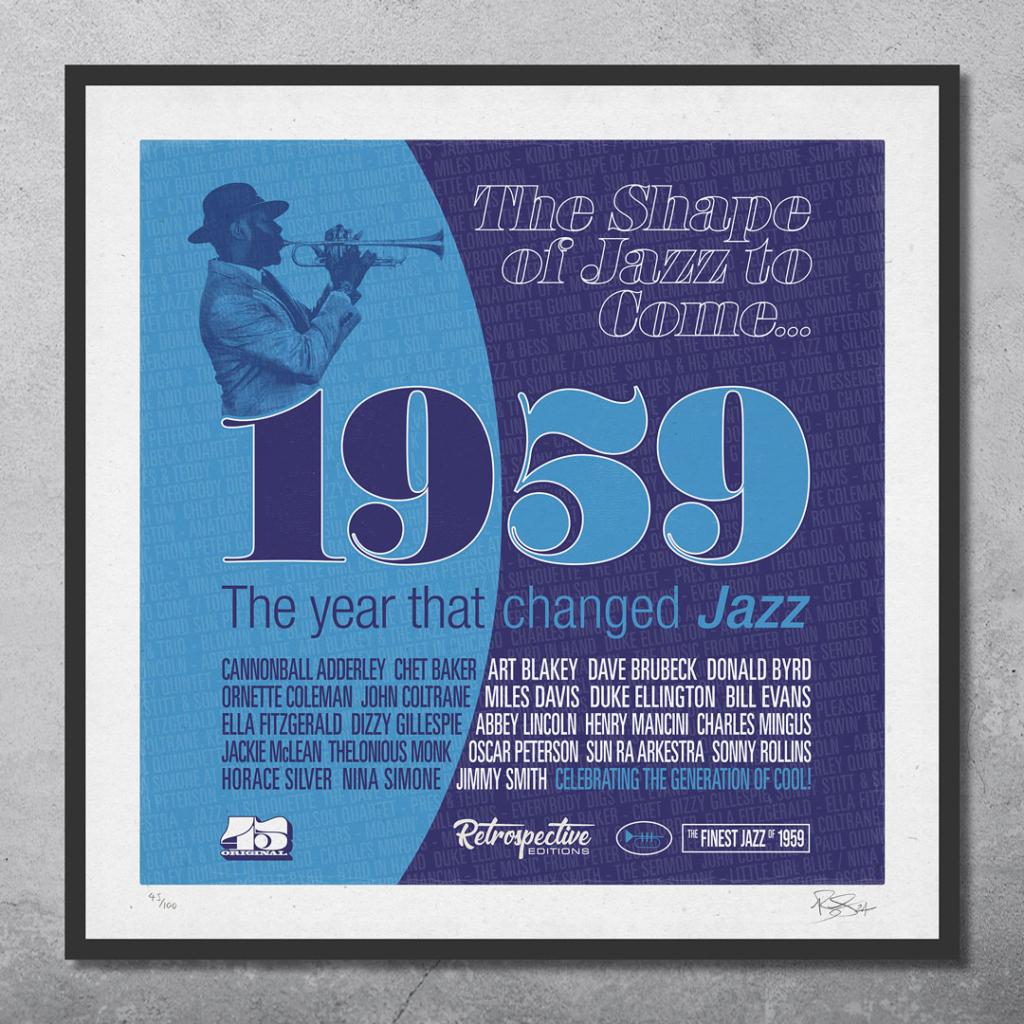
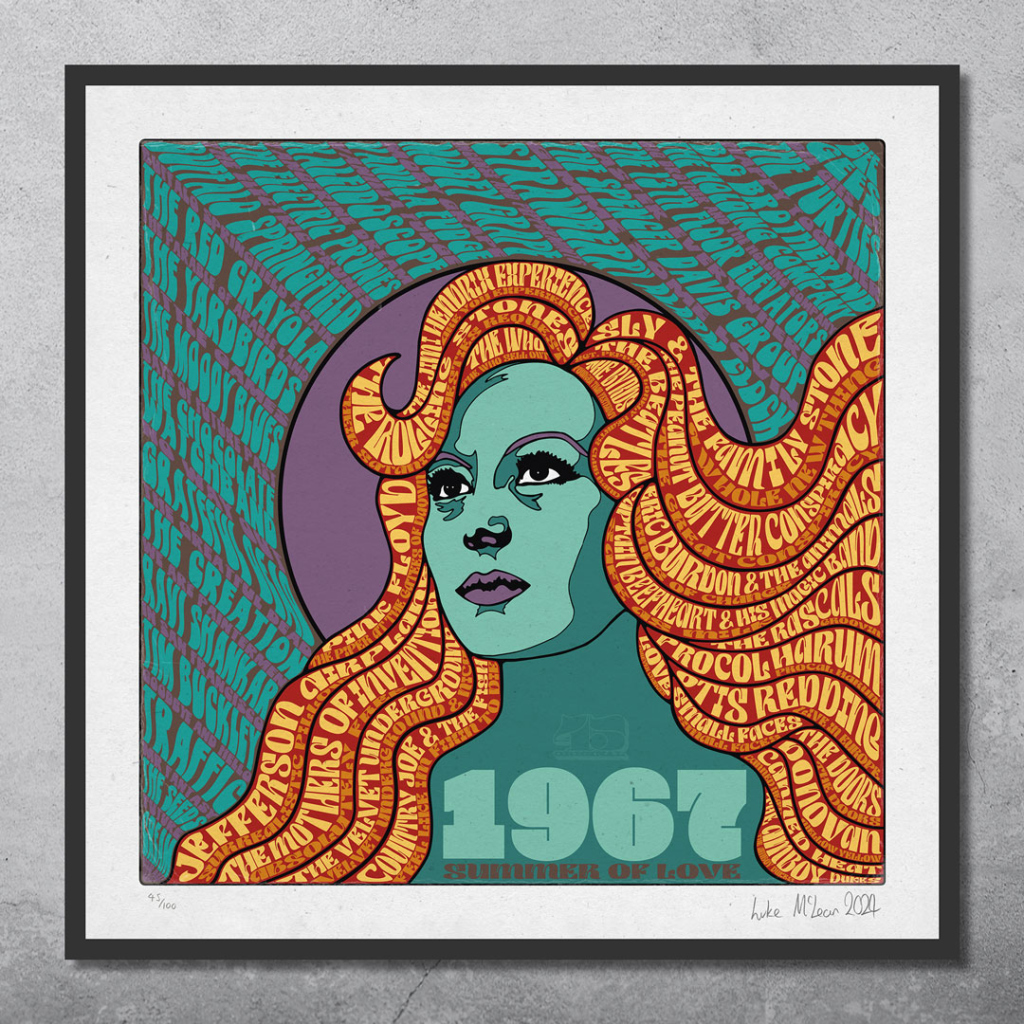
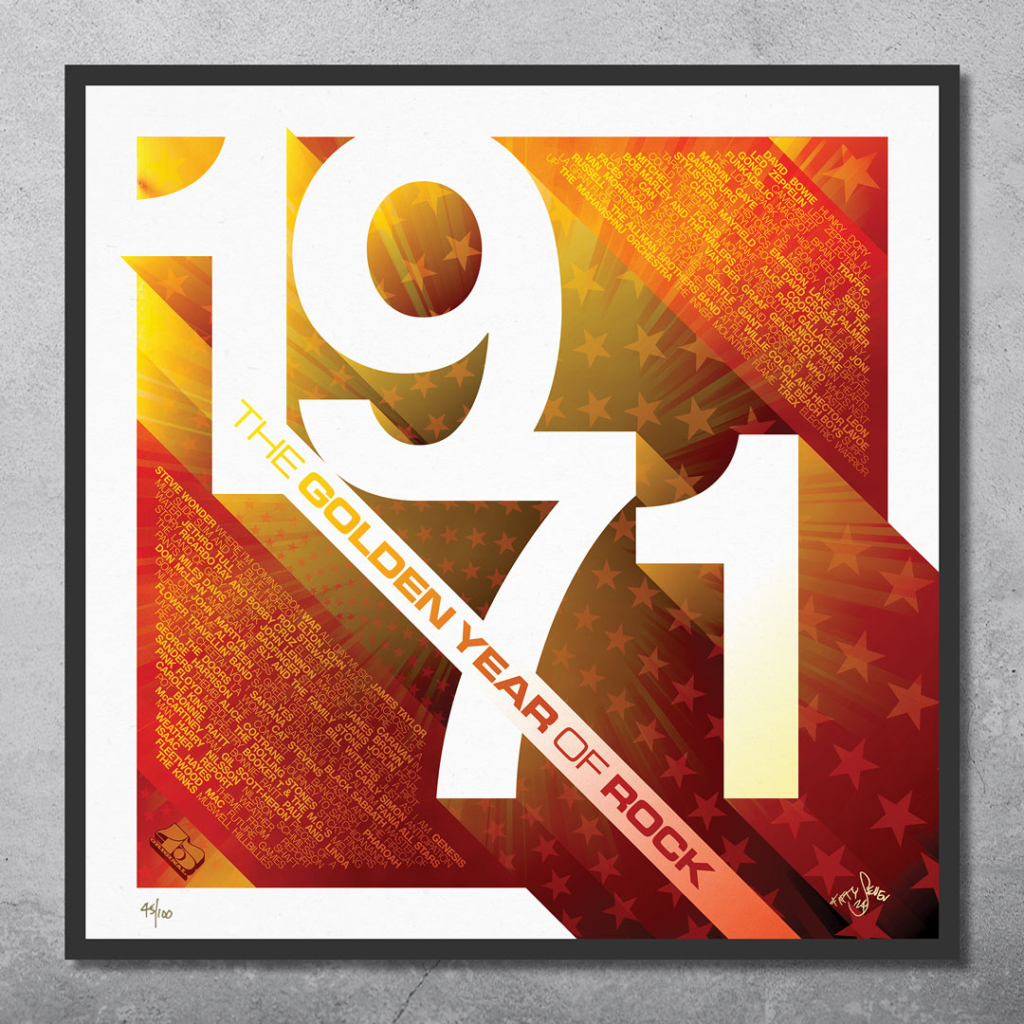
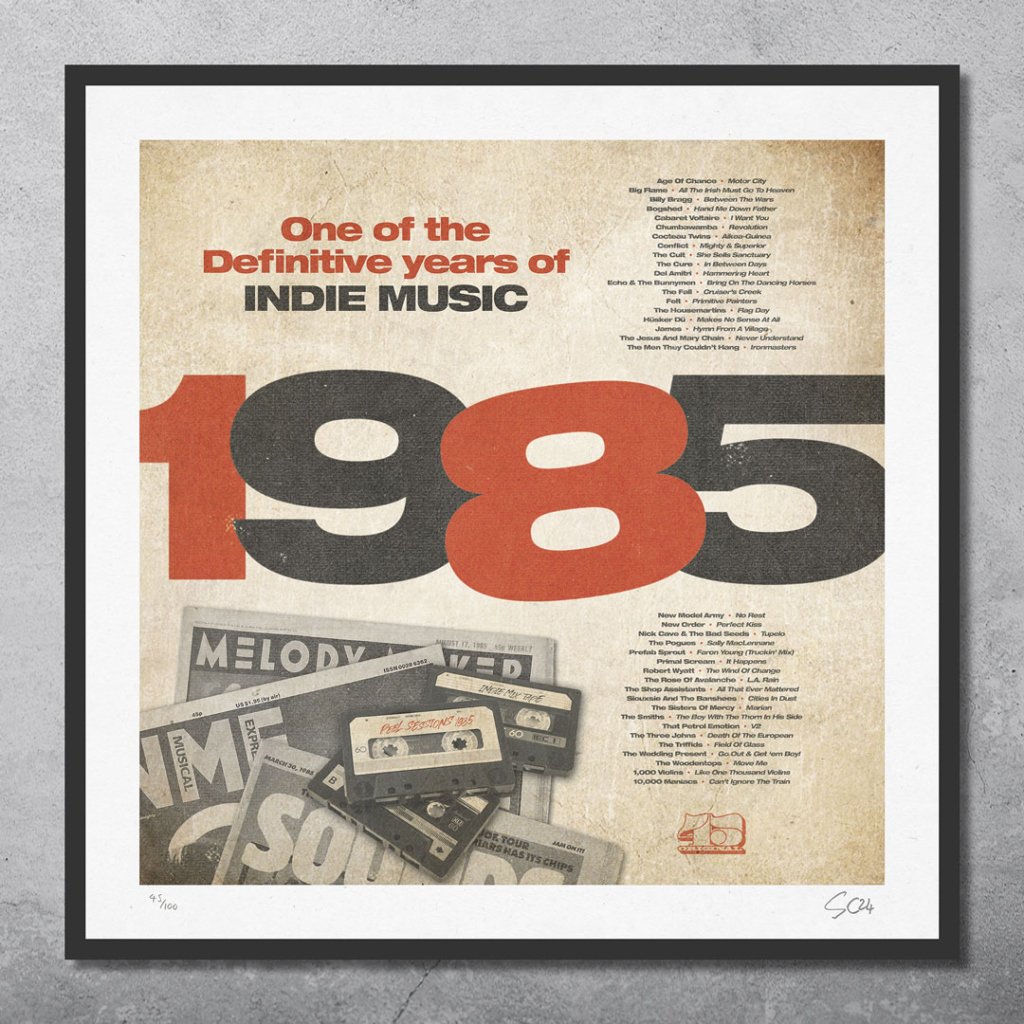
1959 – THE YEAR THAT CHANGED JAZZ
The year 1959 holds significant importance in the history of jazz, marking a pivotal moment in the genre’s evolution. Renowned jazz historian Nat Hentoff famously referred to 1959 as “the year that changed jazz,” highlighting the release of several seminal albums that pushed the boundaries of the genre and reshaped it forever.
One of the most iconic albums released in 1959 was “Kind of Blue” by Miles Davis. This album, recorded in two sessions in March and April of that year, is widely considered as one of the greatest jazz albums of all time. Featuring innovative musical improvisation and an incredible line-up of musicians including John Coltrane and Bill Evans. “Kind of Blue” represented a departure from the prevailing bebop style of the era and had a significant impact on the direction of jazz.
Another ground-breaking release from 1959 was “The Shape of Jazz to Come” by Ornette Coleman. This album introduced the world to Coleman’s pioneering “free jazz” style, characterized by its lack of traditional chord changes and formal structure. Coleman’s adventurous approach to improvisation challenged traditional conventions and opened new possibilities for jazz expression.
Additionally, Charles Mingus released “Mingus Ah Um” in 1959, which showcased his eclectic style and masterful bass playing. The album featured a diverse range of compositions, from hard-swinging blues to heart-rending ballads, reflecting Mingus’s deep musical versatility, but also how his music was a mouthpiece for his social activism, seen in “Fables of Faubus” a written protest.
Furthermore, Dave Brubeck’s “Time Out” also made its debut in 1959, featuring unconventional time signatures and innovative compositions such as the iconic “Take Five.” This album became one of the best-selling jazz albums of all time and introduced audiences to new rhythmic possibilities within the genre.
FEATURED ARTISTS
Abbey Lincoln Abbey Is Blue, Art Blakey & The Jazz Messengers Moanin’,Bill Evans Everybody Digs Bill Evans, Cannonball Adderley Quintet Cannonball Adderley Quintet in Chicago, Charles Mingus Mingus Ah Um, Chet Baker Chet, Dizzy Gillespie, Sonny Stitt & Sonny Rollins Sonny Side Up, Donald Byrd Byrd in Hand, Duke Ellington Anatomy of a Murder, Ella Fitzgerald Ella Fitzgerald Sings The George & Ira Gershwin Song Book, Henry Mancini The Music from Peter Gunn, Idrees Sulieman, John Coltrane, Kenny Burrell & Tommy Flanagan The Cats, Jackie McLean New Soil, Jimmy Smith The Sermon, John Coltrane & Paul Quinichette Cattin’ with Coltrane and Quinichette, Miles Davis Kind of Blue / Porgy & Bess, Nina Simone Little Girl Blue / Nina Simone at Town Hall / The Amazing Nina Simone, Ornette Coleman The Shape of Jazz to Come / Tomorrow Is the Question!, Oscar Peterson Ben Webster Meets Oscar Peterson, Sonny Rollins Newk’s Time, Sun Ra Sound Sun Pleasure, Sun Ra & His Arkestra Jazz in Silhouette, The Dave Brubeck Quartet Time Out, The Horace Silver Quintet & Trio Blowin’ The Blues Away, The Lester Young & Teddy Wilson Quartet Pres & Teddy, Thelonious Monk 5 By Monk By 5.

1967 – THE SUMMER OF LOVE
The year 1967 marked a significant period in American history known as the “Summer of Love,” born in San Francisco but signified by cultural, social, and political movements. This era reflected a convergence of various factors, including the civil rights movement, the anti-war movement against the Vietnam War, and the rise of counterculture.
Politically, the United States was experiencing turbulence and polarization. The civil rights movement, led by figures such as Martin Luther King Jr., was advocating for racial equality and justice. The struggle for civil rights reached a peak in the mid-1960s with events such as the Selma to Montgomery marches and the passage of the Civil Rights Act of 1964 and the Voting Rights Act of 1965.
Simultaneously, opposition to the Vietnam War was mounting, with protests and demonstrations across the nation. Young people, in particular, were vocal in their opposition to the war, which they viewed as unjust and imperialistic. The Summer of Love became a focal point for anti-war sentiment, as thousands gathered in San Francisco to express their disillusionment with mainstream society and the government’s policies.
San Francisco, particularly the Haight-Ashbury district, emerged as the epicentre of the counterculture movement during the Summer of Love. The area attracted thousands of young people seeking freedom of expression, experimentation with drugs like LSD, and communal living arrangements. The cultural landscape of San Francisco was transformed by the influx of artists, musicians, and activists who embraced the ideals of peace, love, and personal liberation.
The Summer of Love was characterized by iconic events such as the Human Be-In, A Gathering Of The Tribes concert in January – where Timothy Leary set the tone of the era with his phrase “Turn On, Tune In, Drop Out.” The Monterey Pop Festival was held in June, which featured performances by renowned artists and speakers like Jefferson Airplane, Grateful Dead, Janis Joplin, Santana, Allen Ginsberg, Jimi Hendrix, The Who, Otis Redding, The Byrds, Buffalo Springfield, Ravi Shankar, Simon & Garfunkel, The Beach Boys and The Mama and Papas – whose John Philips and Lou Adler organised the festival. These events served as platforms for spreading the messages of unity, artistic expression, and social change that defined the counterculture movement.
The Summer of Love of 1967 was a pivotal moment in American history, marked by political activism, social upheaval, and cultural experimentation. It represented a significant shift in societal values and norms, with lasting impacts on American culture and politics.
Meanwhile, over on the East Coast in New York City, the counter-counterculture was born with the release of “The Velvet Underground & Nico” LP. Watch this space!
Celebrate “1967 – The Summer of Love” with your own limited edition of 100 500x500mm print. Available to buy here!
FEATURED ARTISTS
The 13th Floor Elevators Easter Everywhere, The Amboy Dukes The Amboy Dukes, The Beatles Sgt. Pepper’s Lonely Hearts Club Band, Bee Gees Bee Gees’ 1st, Big Brother and the Holding Company Big Brother and the Holding Company, Buffalo Springfield Buffalo Springfield Again, The Byrds Younger Than Yesterday, Canned Heat Canned Heat, Captain Beefheart and His Magic Band Safe as Milk, The Chocolate Watchband No Way Out, Country Joe & The Fish I Feel Like I’m Fixin’ to Die, CreamDisraeli Gears, The Creation We Are Paintermen, The Doors The Doors, Donovan Mellow Yellow, The Electric Prunes The Electric Prunes, Eric Burton & The Animals Winds Of Change, Grateful Dead The Grateful Dead, Jefferson Airplane Surrealistic Pillow, The Jimi Hendrix Experience Are You Experienced, Kaleidoscope Tangerine Dream, Love Forever Changes, Moby Grape Moby Grape, The Moody Blues Days Of Future Passed, The Mothers of Invention Absolutely Free, Otis Redding Live In Europe, The Peanut Butter Conspiracy The Great Conspiracy, Pink Floyd The Piper at the Gates of Dawn, Procol Harum Procol Harum, The Rascals Groovin’, Ravi Shankar In San Francisco, The Red Crayola The Parable Of Arable Land, The Rolling Stones Their Satanic Majesties Request, The Seeds Future, Sly & The Family Stone A Whole New Thing, Small Faces Small Faces, The Spencer Davis Group Gimme Some Lovin’, Strawberry Alarm Clock Incense and Peppermints, The Turtles Happy Together, The Velvet Underground Velvet Underground And Nico, The Who The Who Sell Out, The Yardbirds Little Games, Tim Buckley Goodbye and Hello, Traffic Mr. Fantasy, Vanilla Fudge Vanilla Fudge.

1971 – THE GOLDEN YEAR OF ROCK
The year 1971 saw the music industry experience a transformative period against a backdrop of political and cultural upheaval. Dubbed “Rock’s Golden Year” by author and broadcaster David Hepworth, this era witnessed the emergence of new artists and the consolidation of established stars, while the world was witnessing one of its most turbulent years.
Key figures in the music world made indelible marks on the industry during this time. The Rolling Stones, for instance, released the seminal album “Sticky Fingers,” which further solidified their status as rock icons. Marvin Gaye’s release of the socially conscious album “What’s Going On,” which not only showcased his musical prowess but also addressed pressing issues of the time, such as civil rights and the Vietnam War, with tracks like “Inner City Blues (Make Me Wanna Holler),” “Mercy, Mercy Me” and “What’s Happening Brother.”
David Bowie, a visionary artist known for his boundary-pushing creativity, released the album “Hunky Dory” which featured classic tracks such as “Changes,” “Oh You Pretty Thing,” “Life On Mars” and “Queen Bitch.” Bowie’s experimental approach and theatrical persona captivated audiences and influenced generations of musicians to come.
Meanwhile, John Lennon, released “Imagine” the album and single, a timeless anthem for peace and unity that remains one of the best-selling singles of his solo career. The song’s poignant lyrics and simple melody struck a chord with listeners worldwide, solidifying Lennon’s reputation as a musical visionary and activist.
The year 1971 witnessed an unprecedented surge in record sales, reflecting the public’s hunger for new sounds and voices. The sheer volume of successful releases overwhelmed record companies, underscoring the profound impact of the music industry on popular culture at the time.
1971 stands out as a pivotal year in music history, characterized by artistic innovation, cultural resonance, and social relevance. The releases of ground-breaking albums and singles by as well as the above but also by iconic artists such as Al Green, Alice Cooper, Bill Withers, Black Sabbath, Bob Marley, Carole King, Curtis Mayfield, Don Mc Lean, Faces, Emerson, Lake and Palmer, Funkadelic, Genesis, Harry Nilsson, Isaac Hayes, Led Zeppelin, Nick Drake, Pink Floyd, Santana, Sly & The Family Stone, T-Rex, The Doors, The Kinks, War and Yes, who all helped shape the multitude of different musical genre landscape of the era and continue to influence contemporary music to this day.
Celebrate “1971 – The Golden Year of Rock” with your own limited edition of 100 500x500mm print. Available to buy here!
FEATURED ARTISTS
Al Green Al Green Gets Next To You, Alice Coltrane Journey To Satchidananda, Alice Cooper Killer, Badfinger Straight Up, Bill Withers Just As I Am, Black Sabbath Master Of Reality, Bob Marley & The Wailers Soul Revolution, Bonnie Raitt Bonnie Raitt, Booker T. & The MG’s Melting Pot, Can Tago Mago, Caravan In The Land Of Grey & Pink, Carly Simon Anticipation, Carole KingTapestry, Cat Stevens Teaser And The Firecat, Curtis Mayfield Roots, David Bowie Hunky Dory, David Crosby If Only I Could Remember My Name, Don McLean American Pie, Elton John Madman Across The Water, Emerson, Lake & Palmer Tarkus, Faces A Nod Is As Good As A Wink… To A Blind Horse, Fania All Stars Live At The Cheetah Vol 1, Fleetwood Mac Future Games, Flower Travellin’ Band Satori, Focus Moving Waves, Funkadelic Maggot Brain, Genesis Nursery Cryme, Gentle Giant Acquiring The Taste, George Harrison The Concert For Bangladesh, Gil Scot-Heron Pieces Of A Man, Gong Camembert Electrique, Harry Nilsson Nilsson Schmilsson, Isaac Hayes – Shaft, James Brown – Hot Pants, James Taylor Mud Slide Slim And The Blue Horizon, Janis Joplin Pearl, Jethro Tull Aqualung, John Lennon Imagine, John Martyn Bless The Weather, Joni Mitchell Blue, Led Zeppelin Led Zeppelin IV, Leon Russell Leon Russell & The Shelter People, Marvin Gaye What’s Going On, Miles Davis Live-Evil, Nick Drake Bryter Layter, Paul & Linda McCartney Ram, Pharoah Sanders Thembi, Pink Floyd Meddle, Ricardo Ray & Bobby Cruz El Bestial Sonido De…, Rod Stewart Every Picture Tells A Story, Rory Gallagher Deuce, Santana Santana III, Serge Gainsbourg Histoire De Melody Nelson, Sly & The Family Stone There’s A Riot Goin’ On, Stevie Wonder Where I’m Coming From, T-Rex Electric Warrior, The Allman Brothers Band At Filmore East, The Beach Boys Surf’s Up, The Doors La Woman, The Kinks Muswell Hillbillies, The Mahavishnu Orchestra The Inner Mounting Flame, The Rolling Stones Sticky Fingers, The Stylistics The Stylistics, The Who Who’s Next, TrafficThe Low Spark Of High Heeled Boys, Van Der Graaf Generator Pawn Hearts, Van Morrison Tupelo Honey, War All Day Music, Weather Report Weather Report, Willie Colon & Hector Lavoe La Gran Fuga, Yes Fragile / The Yes Album.

1985 – ONE OF THE DEFINITIVE YEARS OF INDIE MUSIC
The year 1985 stands out as a definitive moment in the history of indie music. It was a period of cultural vibrancy and artistic innovation within the alternative music scene. Independent labels and underground artists flourished, challenging mainstream conventions and redefining the landscape of popular music.
Central to the culture of indie music in 1985 were influential music publications such as NME (New Musical Express), Melody Maker and Sounds – the Bibles of music fans who did not follow the mainstream. These magazines served as vital platforms for discovering new talent, championing emerging artists, and shaping the tastes of music enthusiasts. Their reviews, interviews, and editorial content played a crucial role in cultivating a sense of community and identity within the indie music scene.
Other notable contributors to the indie music scene of the time were John Peel, Janice Long and Annie Nightingale – legendary radio DJs for BBC Radio 1. Peel’s influential show showcased a diverse array of independent and alternative music, providing exposure to up-and-coming bands and helping to break new acts onto the scene. His eclectic playlists including his annual John Peel’s Festive 50 along with his unwavering support for underground artists made him a revered figure within the indie music community.
In the realm of music distribution, the indie music scene of DIY culture thrived as independent bands and labels released records but were limited in distribution and struggled to forge in-roads around the UK mainstream shops. In light of this, fans of music not of the Top 40, would record their favourite indie tracks/sessions on cassettes, enjoying for their importance and sharing with friends. Another big market was the recording of Bootleg Live Concerts on cassettes and selling, however, they were all generally pretty poor quality. Nonetheless, this grassroots approach to distribution empowered artists to maintain creative control over their music and connect with audiences on a more intimate level.
Many classic indie tracks were released this year by bands such as Billy Bragg, Cabaret Voltaire, Cocteau Twins, The Cult, The Cure, Echo & The Bunnymen, The Fall, Felt, Hüsker Dü, James, The Jesus and Mary Chain, New Model Army, New Order, Nick Cave & The Bad Seeds, The Pogues, Prefab Sprout, Primal Scream, The Sisters Of Mercy, The Smiths, The Petrol Emotion, The Wedding Present, The Woodentops, R.E.M., New Order, The Fall and Sonic Youth; all of who were at the forefront of the indie music movement, each contributing their unique sound and aesthetic to the cultural landscape. Their music embodied the spirit of independence, experimentation, and authenticity that defined the indie ethos of the time. Some of the above artists’ releases were on an array of Indie labels, including Rough Trade, Factory, Creation, Mute, 4AD, Stiff, Cherry Red, Beggars Banquet, Kitchenware and Merciful Release to name a few.
1985 represents a pivotal moment in the evolution of indie music, characterized by a flourishing subculture of independent artists, labels, and publications. The convergence of NME, Melody Maker, Sounds, Janice Long and John Peel’s radio shows, cassette tape distribution, and iconic bands helped solidify indie music as a significant force in the broader musical landscape, leaving an indelible mark on music history.
Celebrate “1985 – One of the Definitive Years of Indie Music” with your own limited edition of 100 500x500mm print. Available to buy here!
FEATURED ARTISTS
1,000 Violins Like One Thousand Violins, 10,000 Maniacs Can’t Ignore The Train, Age Of Chance Motor City, Big Flame All The Irish Must Go To Heaven, Billy Bragg Between The Wars, Bogshed Hand Me Down Father, Cabaret Voltaire I Want You, Chumbawamba Revolution, Cocteau Twins Aikea-Guinea, Conflict Mighty & Superior, Del Amitri Hammering Heart, Echo & The Bunnymen Bring On The Dancing Horses, Felt Primitive Painters, Hüsker Dü Makes No Sense At All, James Hymn From A Village, New Model Army No Rest, New Order Perfect Kiss, Nick Cave & The Bad Seeds Tupelo, Prefab Sprout Faron Young (Truckin’ Mix), Primal Scream It Happens, Robert Wyatt The Wind Of Change, Siouxsie And The Banshees Cities In Dust, That Petrol Emotion V2, The Cult She Sells Sanctuary, The Cure In Between Days, The Fall Cruiser’s Creek, The Housemartins Flag Day, The Jesus And Mary Chain Never Understand, The Men They Couldn’t Hang Ironmasters, The Pogues Sally MacLennane, The Rose Of Avalanche L.A. Rain, The Shop Assistants All That Ever Mattered, The Sisters Of Mercy Marian, The Smiths Meat Is Murder, The Three Johns Death Of The European, The Triffids Field Of Glass, The Wedding Present Go Out & Get ‘em Boy!, The Woodentop Move Me.

In view of COVID’s decimation of the live entertainment sector, 10% of 45 Original’s My Generation sales profits will be donated to the MUSIC VENUE’S TRUST ‘Save Our Venues’ Campaign.
45 Original is a creative platform celebrating UK live music culture through bespoke limited edition designs and offers a long-awaited window for designers who talents so often go under the radar.
Previous collections and designs include:
